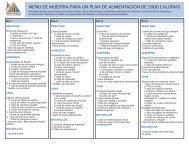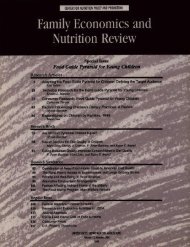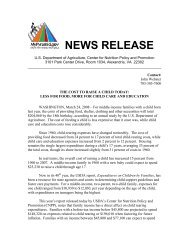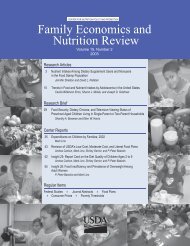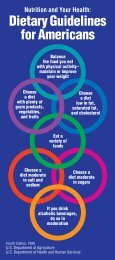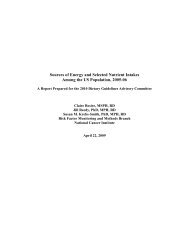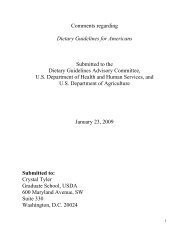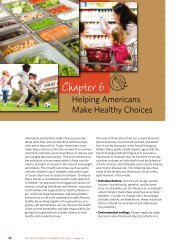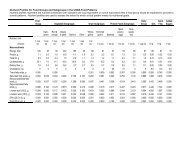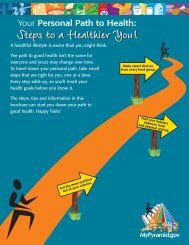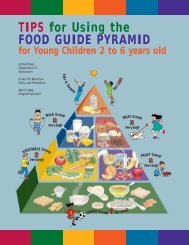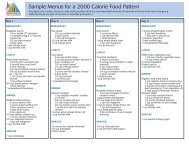Elderly Nutrition - Center for Nutrition Policy and Promotion - US ...
Elderly Nutrition - Center for Nutrition Policy and Promotion - US ...
Elderly Nutrition - Center for Nutrition Policy and Promotion - US ...
Create successful ePaper yourself
Turn your PDF publications into a flip-book with our unique Google optimized e-Paper software.
Table 3. Diet <strong>and</strong> disease restrictions <strong>for</strong> single elderly women<br />
Variable Total 1 Rural 1 Nonrural 1<br />
Percent<br />
Diet restrictions 26 23 26<br />
Lowfat 4 4 4<br />
Low calorie 14 12 14<br />
Low sodium 9 7 10<br />
High fiber 3 1 3<br />
Diabetic 7 7 7<br />
Diagnosed diseases<br />
Circulatory 69 71 68<br />
High blood pressure 51 51 51<br />
Heart disease 23 27 21<br />
High blood cholesterol 30 29 31<br />
Stroke 7 6 8<br />
Diabetes 14 14 15<br />
Cancer 12 17 9<br />
Osteoporosis 13 13 12<br />
Study findings indicate that<br />
single elderly women’s economic<br />
resources are more important<br />
than knowledge resources in<br />
attaining adequate nutrition.<br />
1 Sample size: total = 732, rural = 218, <strong>and</strong> nonrural = 514.<br />
residents reported diagnosis of high<br />
blood cholesterol, stroke, or diabetes.<br />
Both rural <strong>and</strong> nonrural residents had<br />
equal rates of diagnosed high blood<br />
pressure (51 percent).<br />
Results of the multivariate analysis<br />
indicate that economic resources, <strong>and</strong><br />
various constraining <strong>and</strong> facilitating<br />
conditions were significant in explaining<br />
variation in nutritional adequacy<br />
among single women age 65<br />
<strong>and</strong> older (table 4). In rank order of<br />
importance, the significant factors<br />
were Midwest residence, taking a<br />
daily multivitamin/multimineral,<br />
employment (full or part time), income<br />
as a percent of poverty, presence of<br />
circulatory disease, receipt of food<br />
stamps, <strong>and</strong> rural residence. In terms<br />
of direction of association, Midwest<br />
residence, taking a daily multivitamin/<br />
multimineral, higher levels of income,<br />
<strong>and</strong> presence of circulatory disease<br />
were associated with higher levels of<br />
nutritional adequacy. Employment,<br />
receiving food stamps, <strong>and</strong> rural<br />
residence, however, were associated<br />
with lower levels of nutritional<br />
adequacy.<br />
Discussion <strong>and</strong> Implications<br />
Study findings indicate that single<br />
elderly women’s economic resources<br />
are more important than knowledge<br />
resources in attaining adequate<br />
nutrition. The positive relationship<br />
between income <strong>and</strong> nutrition<br />
adequacy is consistent with previous<br />
research (Brown, 1987; Sahyoun &<br />
Basiotis, 2001; Hendy et al., 1998;<br />
Qu<strong>and</strong>t & Rao, 1999; Quinn et al., 1997)<br />
<strong>and</strong> with the idea that a higher quality<br />
diet costs more (Blaylock et al., 1999).<br />
It is reasonable to expect that those<br />
with limited resources would benefit<br />
from the Federal Food Stamp Program.<br />
Thus, the negative relationship<br />
between receipt of food stamps <strong>and</strong><br />
nutrition adequacy is contrary to what<br />
would be expected. It could be that, as<br />
Shotl<strong>and</strong> <strong>and</strong> Loonin (1988) contend,<br />
benefit levels are too low to really meet<br />
the need. It certainly appears that,<br />
<strong>for</strong> whatever reason, food stamp<br />
participants in this sample still do not<br />
acquire the quantity <strong>and</strong> quality of<br />
food necessary to get adequate<br />
2003 Vol. 15 No. 1 79



